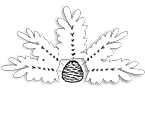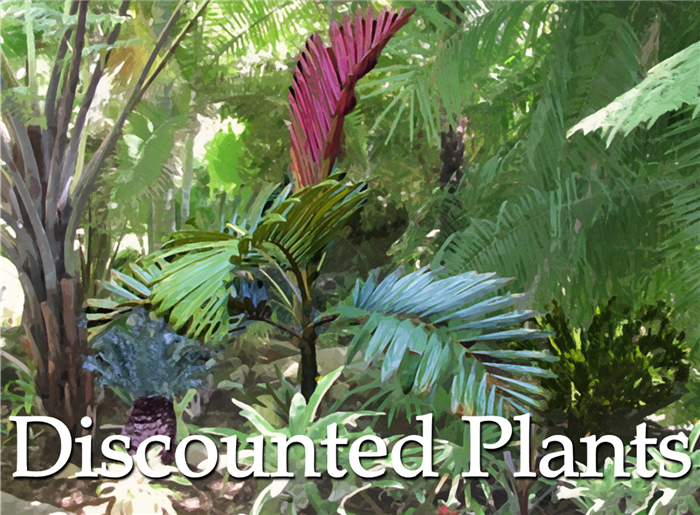GREAT COLD HARDY PALM SPECIES YOU’LL NOT FIND EASILY
by Phil Bergman, Jungle Music
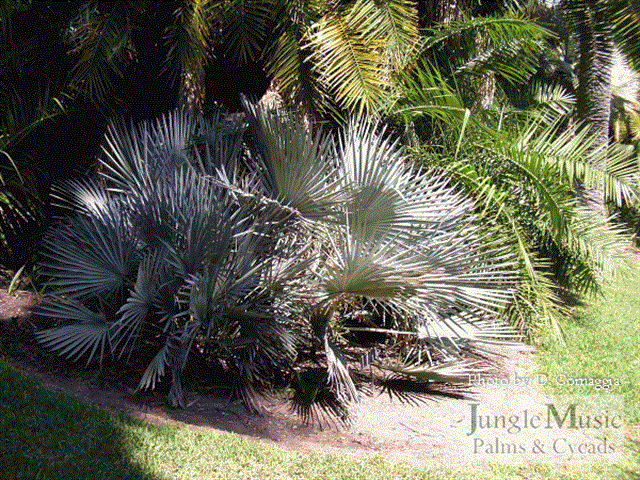
Description of Article
This article will quickly show you some unusual cold hardy palm species that we usually have available and are shippable to all areas of the U.S. Most of those shown are the 15g size. The aim here is to introduce you to very cold hardy and unusual palm species. But, to also show a means of affordably transporting larger specimens right to your door. This is by utilizing plants packed onto a pallet which is shipped by trucking service, at affordable rates throughout the country. Check below to see the plants and how we do it.

customer in Northern California
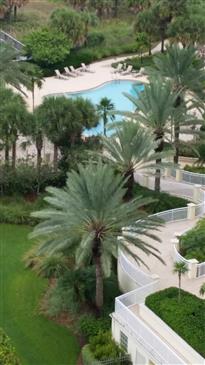
Introduction
Perhaps you live in an area that experiences cold. But, you’d like to try some palm trees that are not locally available. This article will give you a look at some of the unusual species we carry. And, almost all are fairly cold hardy. Also, be aware that larger, established palm trees have a better chance of survival when exposed to cold winters. The palms we’re showing below are mostly in a 15g pot with some age. The species listed below are not a totally comprehensive list, but rather a selection of just some of the things we propagate and offer for sale.
I the past several years we’ve developed a very economical way to ship these larger plants. The pallet method of shipping means a customer buys enough plants to totally fill a pallet that is shipped by truck to you. When properly selected and packed on, it’s one of the most affordable delivery methods around.
A QUICK LOOK AT SOME DESIRABLE RARE YET COLD HARDY PALM SPECIES
AND HOW THEY ARE SHIPPED TO YOU
Customers call us and want palm trees they can grow in their cooler area but in larger sizes. Mature trees (30 to 60 inch boxes) require cranes and flatbed trucks for loading, planting and transport. This can end up being very expensive. But, there is a way you can get a reasonably sized palms and yet not have to pay super high costs to get them to your area. This is by loading plants on a pallet and sending the pallet through an independent trucking company. After an order is placed, we load up the pallet with up to fifteen larger 15 or 25g plants (could be 24 inch boxes as well) and piggy back another ten or so 5 gallon plants with the bigger ones. Of course, the shipping costs depend on where you live and the size and weight of the pallet. But, to many areas, we can ship pallets are fairly affordable rates. Contact us for a quote. We are in CA so the further away you are, the more the trucking fee. But, when you figure the cost per plant, it sure beats common carriers like Federal Express or U.P.S. and many times they can’t transport large plants like we get onto a pallet. All these larger sized plants fit nicely onto a pallet. We can get on plants up to nine feet tall in their pots. All plants travel vertically on the pallet.
Most of the plants described below will take temperatures into the low 20’s F. and some into the mid-teens. In other words, these plants will do well in areas like the San Joaquin Valley in California, Sacramento and the SF Bay area, Houston, Texas and many areas in the southeastern states in the U.S.
Below, I’ll make only a few basic comments on culture and cold tolerance. I’ll mostly concentrate on showing you the plants in sizes for good pallets (or boxed mail order) so you get to know them. I won’t cover common species your likely to find available where you live – like the Queen Palm, The Mexican Fan Palm, the common Windmill palm or the “not cold hardy at all” Pygmy Date Palm. Be aware, the illustrated species below are not a totally comprehensive list in any fashion. There are many more palms that we grow that might do well for you and are cold hardy. I can’t show them all here. We do try to keep all of these species in stock in these 15g sizes as well as smaller and sometimes larger sizes in 25g or boxes. These can be put on a pallet as well. Just give us a call and we can ship to you these sizes as well. Where possible, I’ll try to show a photo of a mature specimen of the species being discussed.
REMEMBER: YOU ALWAYS SAVE 15% OFF REGULAR PRICES WHEN YOU ORDER A PALLET OF PLANTS!
PHOTOS BELOW OF JUNGLE MUSIC NURSERY, GARDEN AND HABITAT PALMS
ACOELORRAPHE WRIGHTII
THE PAUROTIS PALM
SUCKERING, MEDIUM HEIGHT
This suckering fan palm in native to everglade and tropical areas in southern Florida, Mexico and Central America. In the wild, plants can get up to 30 feet. But, here in California, plants are usually about fifteen feet tall. Trunks are narrow and individual leaves are perhaps three feet across. This species likes sun and water. Cold hardiness is about 20 degrees. The nursery plant shown here is a 5g palm.
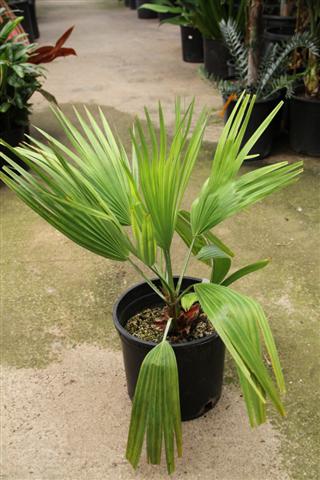
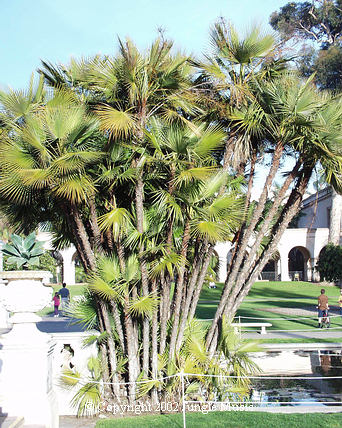

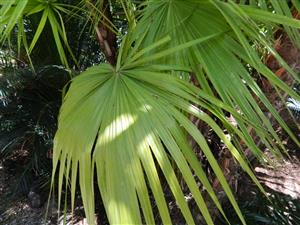
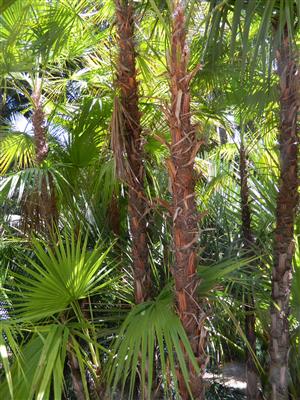
ALLAGOPTERA ARENARIA
THE SEASHORE PALM
CLUSTERING, DWARF PALM
This pinnate palm rarely gets over six feet tall, is native to coastal Brazil and has fluffy leaves (plumose). It’s a sun species with a cold hardiness into the upper teens F.
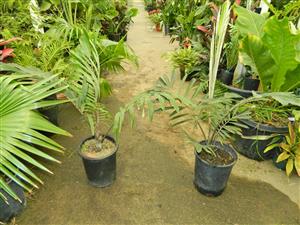
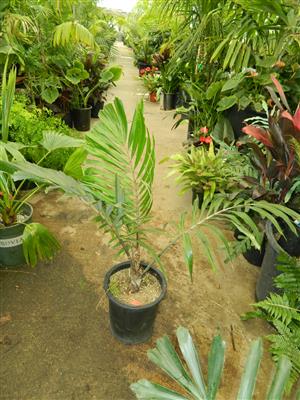

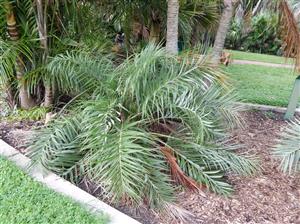
ARENGA ENGLERI
THE DWARF SUGAR PALM
SUCKERING, NOT TOO TALL
This suckering Asian species doesn’t get over about ten feet tall and has silver color to the back of the leaflets. The leaflets have chopped ends. It’ll take coastal sun and part day sun inland. Cold tolerance about 18 degrees F.
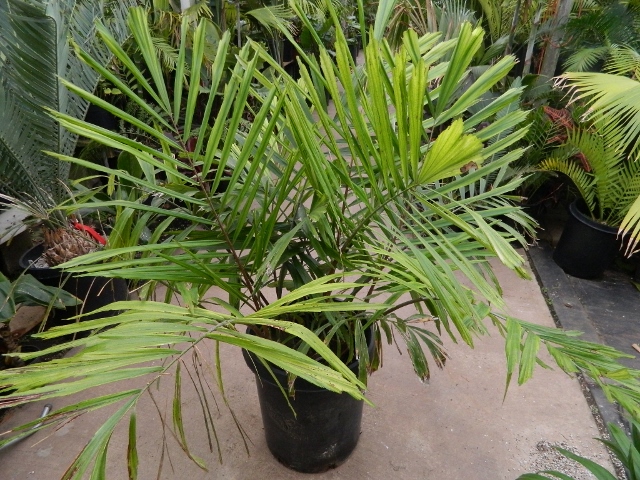
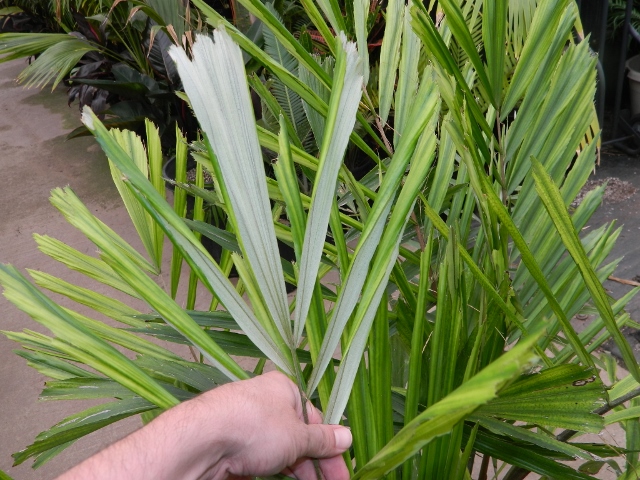
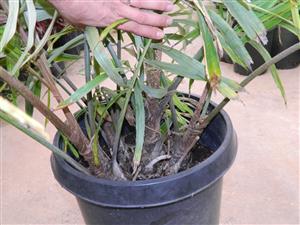
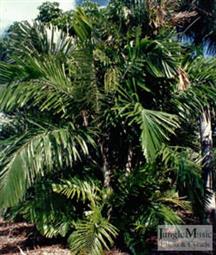
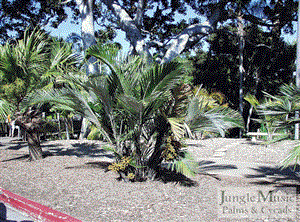
BISMARCKIA NOBILIS
BLUE WITH STATELY APPEARANCE
GORGEOUS FAN PALM
This Madagascar palm species is one of our favorites. It gets to about 35 feet tall with about an 18 inch trunk. The leaves are silver-blue. It’s stunning. It loves hot sun and is cold tolerant to about 20 degrees when large. It doesn’t seem to like weather into the teens.
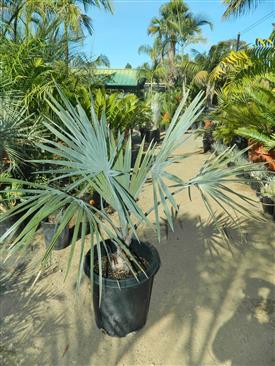
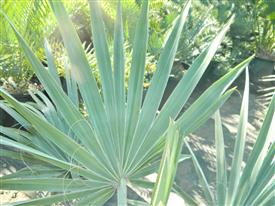
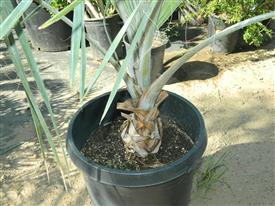
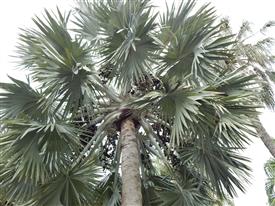

BLUE BUTIA CAPITATA
THE BLUE PINDO PALM
MEDIUM HEIGHT – YES, BLUE COLOR!
This variety of the South American Pindo Palm is super color because of its unusual blue color. It gets to a height of about fifteen feet in three decades and is single trunk. It loves full sun and is cold hardy to 15 degrees F.
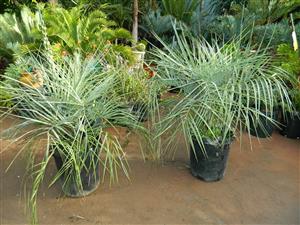
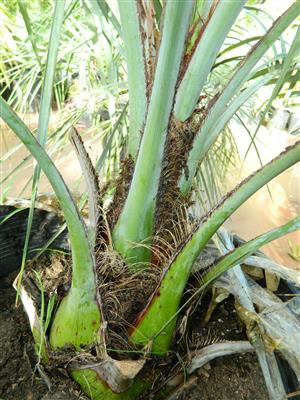
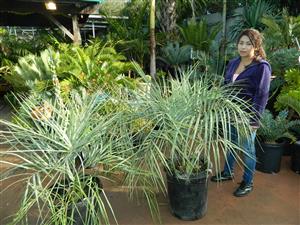
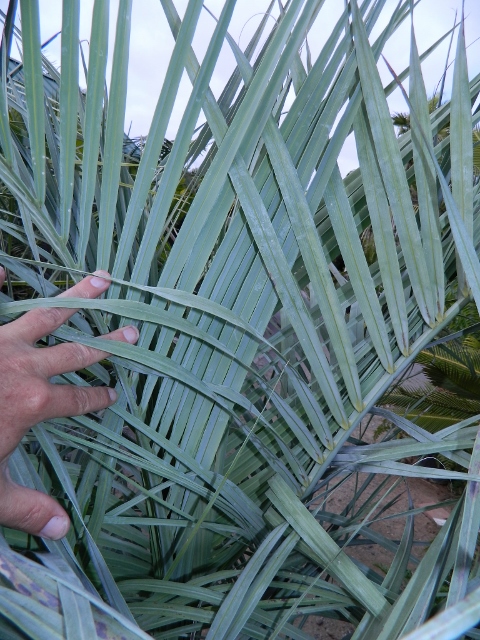

BRAHEA ACULEATA
SINALOA HESPER PALM
MEDIUM SIZED FAN PALM
This fan palm is native to Mexico and gets to a very manageable size of fifteen feet. It has a blue green color and is cold hardy to about 20 degrees F. We try to have 5g and 15g available although this may vary over time.
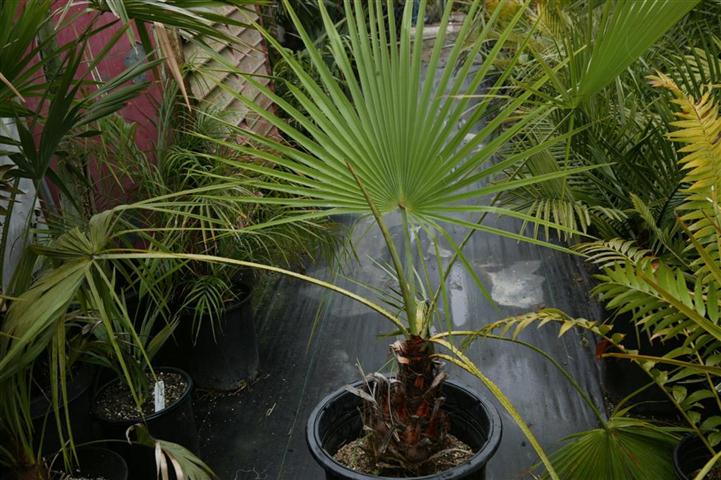
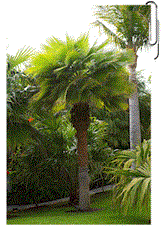
BRAHEA ARMATA
THE MEXICAN BLUE FAN PALM
BLUE, MEDIUM HEIGHT, SUPER BLUE!
In hot sun this species gets extra blue. It is slow growing, gets a trunk typically about 18 inches thick and seems to peak out under 20 feet. Cold hardiness is about 15 degrees F.
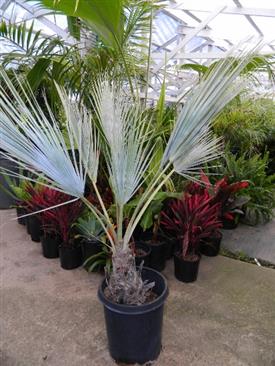
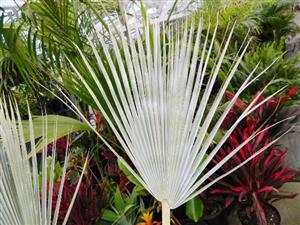
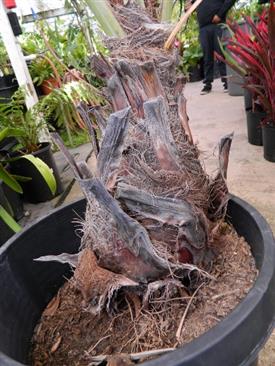
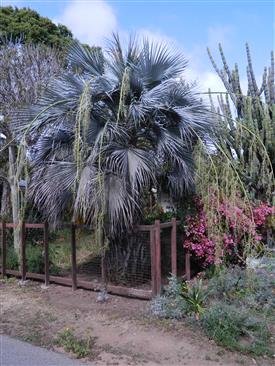
BRAHEA CLARA
BLUE SINGLE TRUNK MEXICAN PALM
SUPER COLD HARDY
This palm is quite similar to the more common Brahea armata. It loves sun, takes cold to 15 degrees and is blue in color. It gets to a height of no more than 20 feet. Compared to the common Mexican Blue Fan Palm, it has longer petioles and is faster growing. Another curious difference we’ve discovered is the stem armor. Rather than simple, uniform curved spines, the armor is more like a bad set of shark’s teeth as shown here.
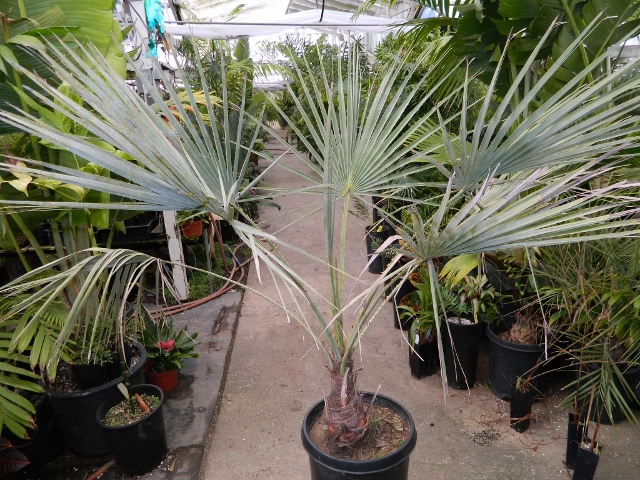
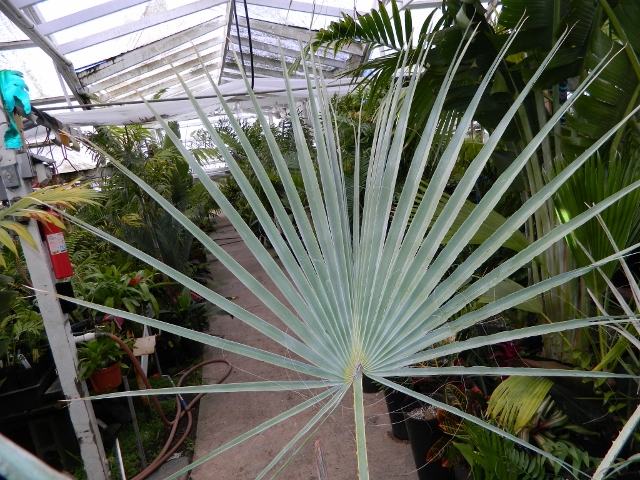
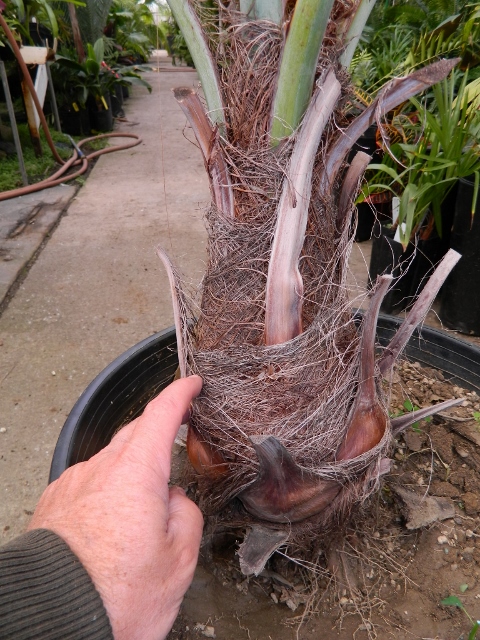
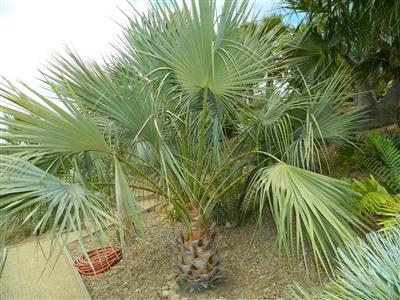
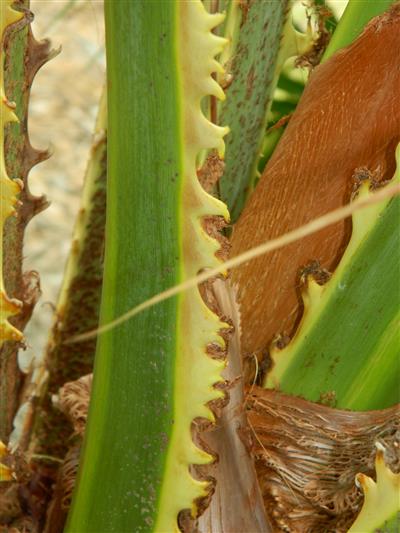
BRAHEA DECUMBENS
BLUE, DWARF AND SUCKERING
EXCELLENT COLD HARDY SMALLER PALM
This suckering species of fan palm develops a blue color with age and sun. Shown is a 5g. We never can keep them in stock to get them to 15g. They love hot sun, get to a height of no more than six feet and sucker. this is an ideal palm where views are a concern. They are very slow growing.
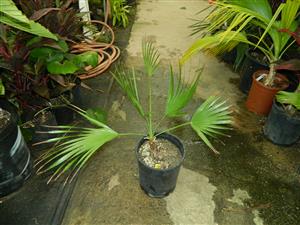
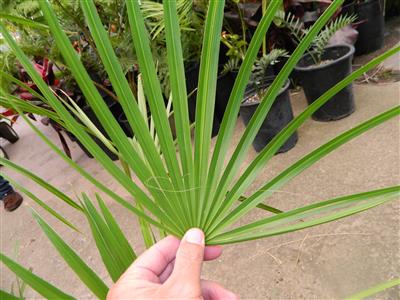
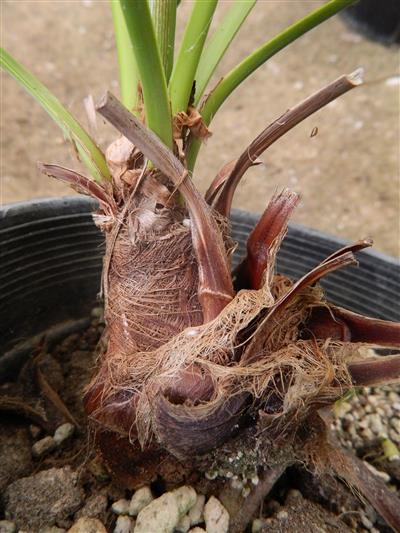
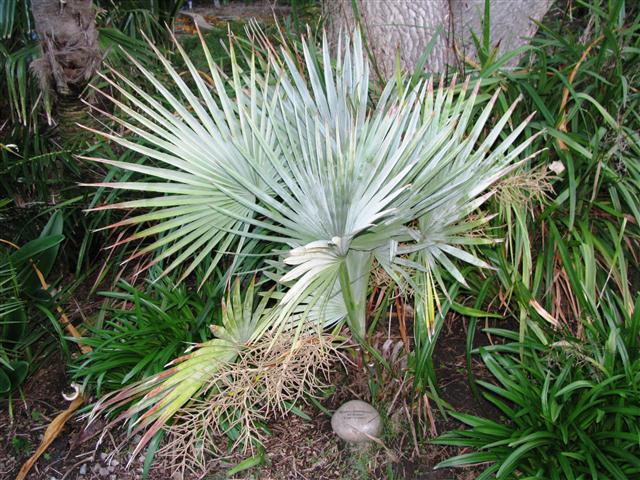
BRAHEA EDULIS
THE GUADALUPE FAN PALM
MEDIUM SIZED UP TO FIFTEEN FEET
This palm is native to an island off the northern coast of Baja California. It has a thick trunk that is smooth but with fine checks. Leaves are flat and green. It takes full sun in almost all areas and is cold hardy to about 17 to 18 degrees F. It’s very slow growing. We usually have the 5g size and sometimes 15g are available.
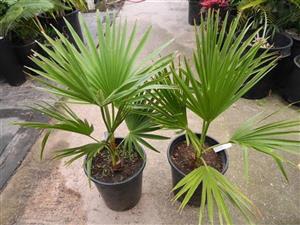

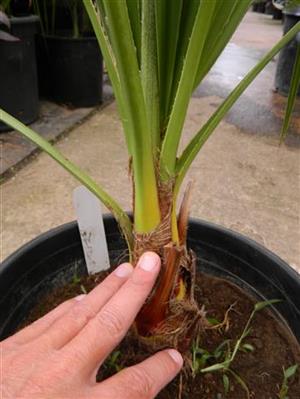

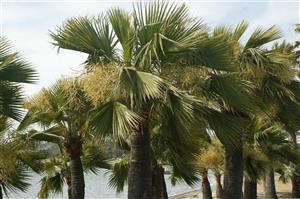
BRAHEA NITIDA
FLAT GREEN LEAVES
TAKES SUN OR PART SUN
This rare species in interesting because it can tolerate part day sun or full sun in most areas. It is medium sized to about 25 feet and cold hardy to about 20 degrees or a bit colder. Also interesting is that leaf stems do not have spines. This is a rare species and availability varies from time to time.
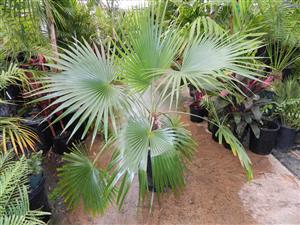
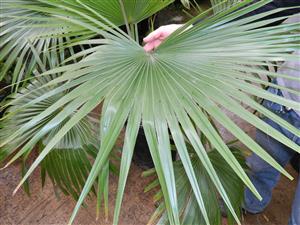
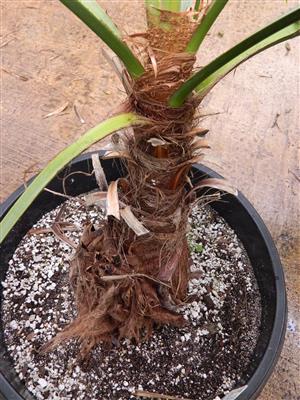
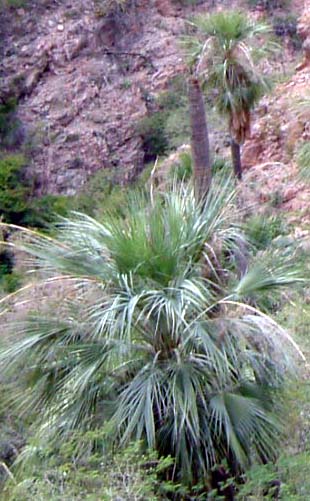
BUTIA X SYAGRUS
THE MULE PALM
HYBRID THAT LOOKS LIKE NEITHER PARENT
This surprisingly very cold hardy palm is being grown in areas that routinely see bad weather. When Queen Palms die in Tucson, AZ, this one survives. It gets to 25 feet and loves hot sun. Some say that, when mature, they look a little bit like a Coconut. It’s also a very good growing hybrid with lots of vigor. It likes sun and is cold hardy to about 16 or 17 degrees.
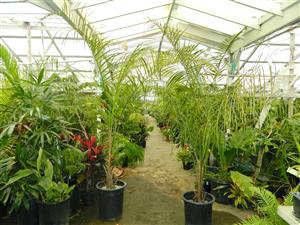
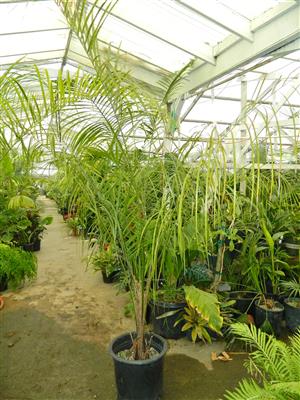
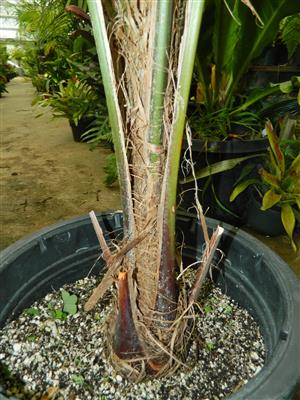
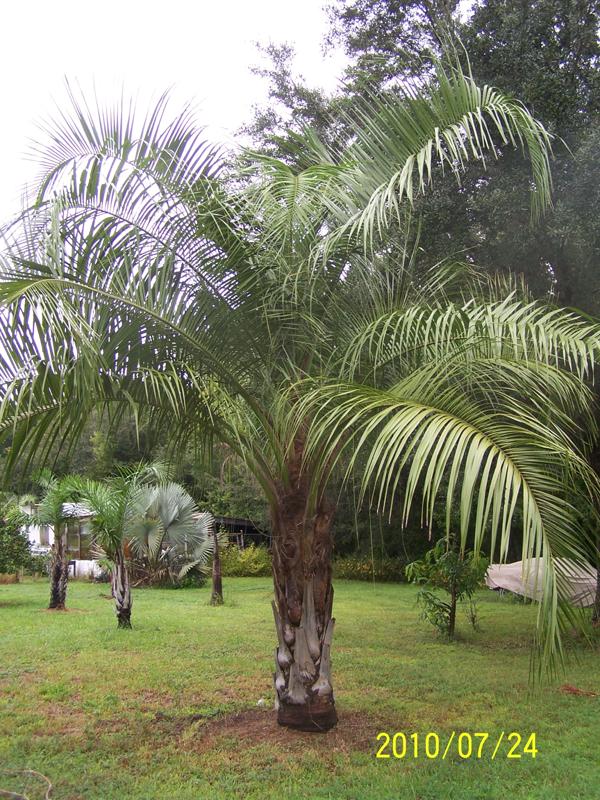
CARYOTA URENS
COLD HARDY MOUNTAIN FISHTAIL
TALL, EXOTIC, BRANCHED LEAF
This exotic species tolerates temperatures to about 19 degrees yet is much more tropical appearing than anything else here. It is quite growing and easily gets above 40 to 50 feet tall. It can grow in full sun if given enough water. It’s a tough grow in desert areas. A unique characteristic is that it has bi-pinnate leaves, leaves that branch off the main stem. Consider this species if you have the room.
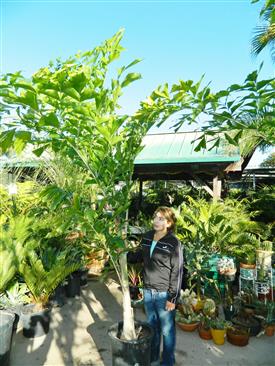
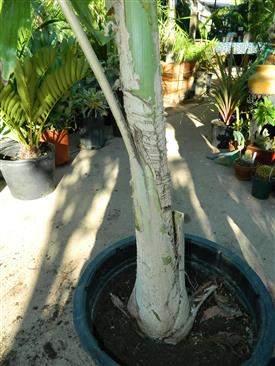
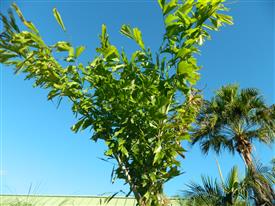
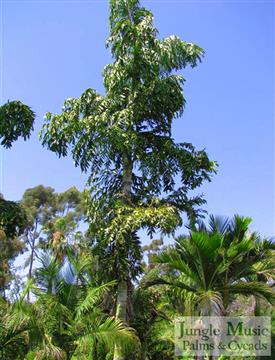
CHAMAEDOREA MICROSPADIX
A TYPE OF BAMBOO PALM
FILTERED LIGHT – TO EIGHT FEET
This exotic species really doesn’t take too much light. It has very thin trunks, gets to eight feet tall and sometimes has velvet type leaves with blue undersides. It is quite petite, the smallest of the Bamboo Palms. Females, when pollenated, produce red seeds. It is cold hardy to about 18 degrees. Unlike almost every other species here, it’s not a full sun palm.
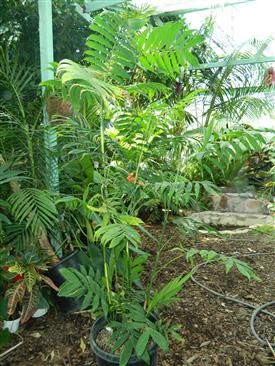
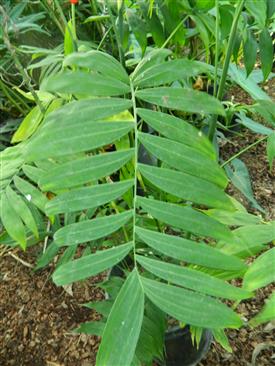
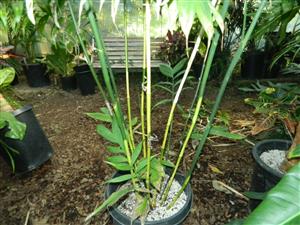
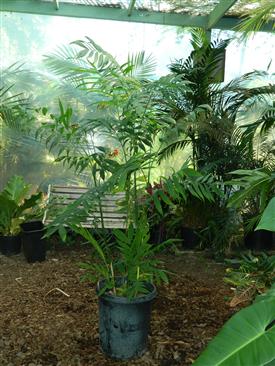

CHAMAEDOREA RADICALIS
TWO FORMS: TRUNKING, REGULAR
MOST COLD HARDY PALM THIS GENUS
FILTERED LIGHT AND MAYBE COASTAL SUN
This new world suckering palm has two forms. The trunking form gets to about ten feet tall. The regular, shorter form gets to about four feet height and has wider leaflets than the tall form. The regular classic form can be easily spotted because female blossoms emerge and tower above the leaves. This palm takes filtered light and coastal mild sun. Cold hardiness is down to about 18 degrees F.
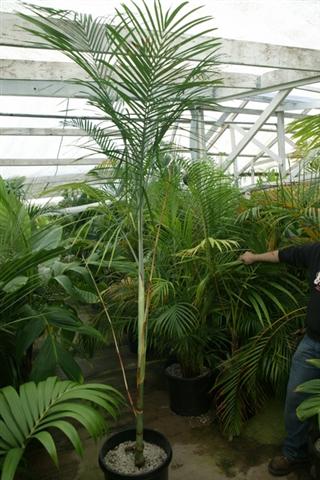
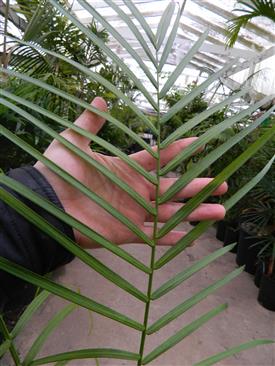
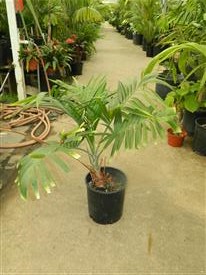
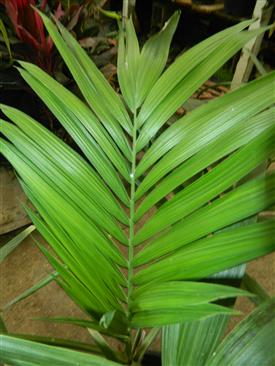
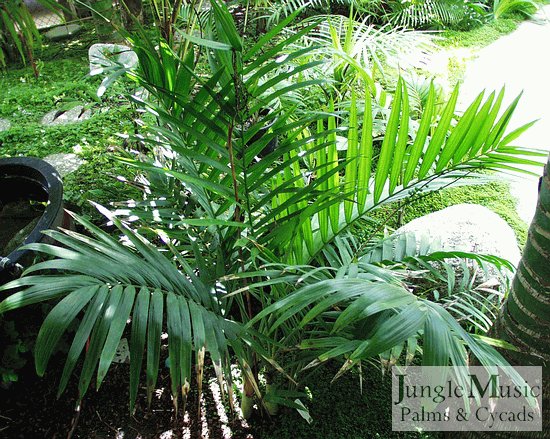
CHAMAEROPS CERIFERA
BLUE SUCKERING FAN PALM
NOT AS BIG AS THE MED FAN
This kissing cousin of the Mediterranean Fan Palm is different in that it is an intense blue color and typically is shorter and more compact. It’s also slower growing. Native to Morocco, it typically is under ten feet tall, loves hot sun and is cold hardy to 15 degrees F.
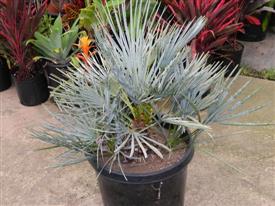
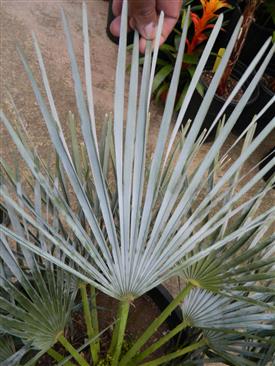
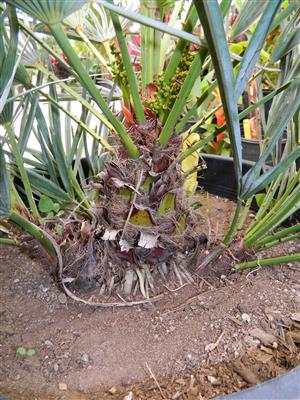
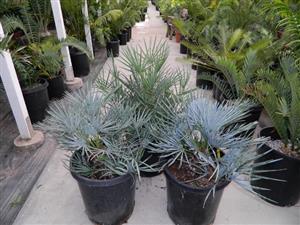

COPERNICIA ALBA
TALL THIN TRUNK
SINGLE STEM FAN PALM
Copernicia is a rare genus of fan palms mostly native to Caribbean Islands such as Cuba. This species has a thin trunk and gets over 40 feet tall. For an exotic genus, it’s surprisingly cold hardy perhaps into the upper teens F. It loves sun and heat.
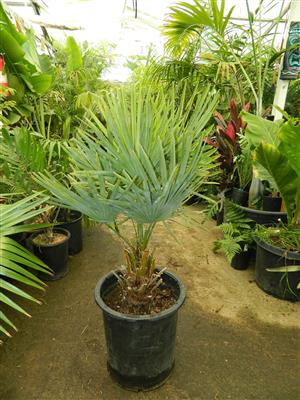
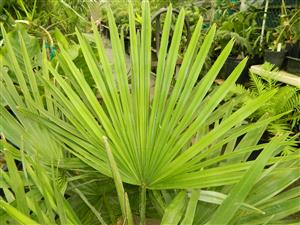

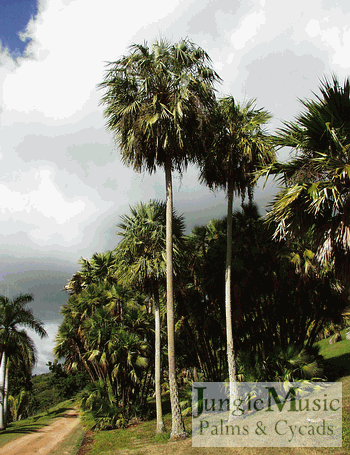
DYPSIS DECIPIENS
DIFFERNT APPEARING
MADAGASCAR SINGLE TRUNK PALM
BUT NOT THE EASIEST TO GROW
I hesitated to include this most interesting tree from Madagascar because some people have difficulty growing it. So, you must be patient with it and follow cultural rules. But, it’s been known to tolerate down to 18 degrees F. Along the coast and in many areas it tolerates full sun. It also likes warmth but not the desert. There are multiple forms of this species including one with a white crown shaft. This is a highly sought after palm
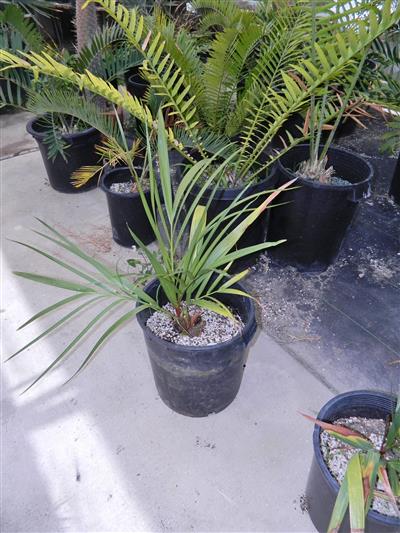
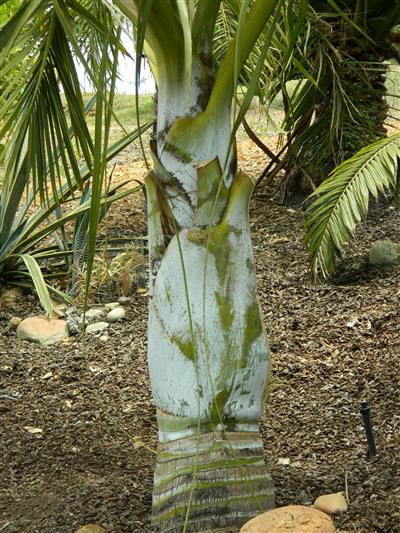
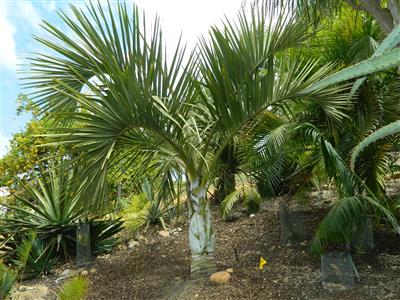
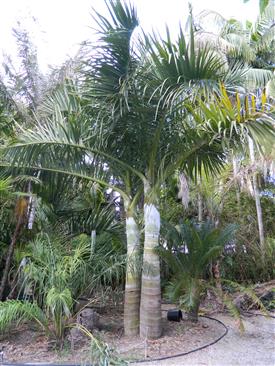

JUBAEA CHILENSIS
CHILEAN WINE PALM
FATTEST TRUNK OF ANY PALM
This thick trunked pinnate palm is slow growing but manages to get a trunk fatter than any other palm. Native to Chile, it can reach a height of 40 feet and trunk diameter of 4 feet. It loves hot sun and is cold hardy to 16 degrees. The 15g plant shown here is 10 years old. This is why this species is more costly than other palms. The trunk is also smooth as shown here with no attached leaf bases.
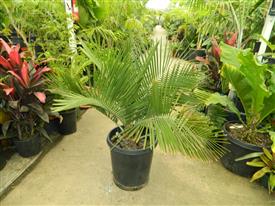
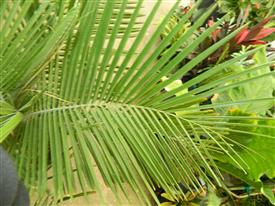
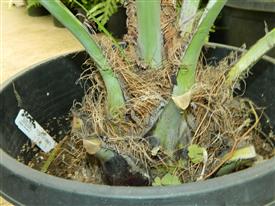
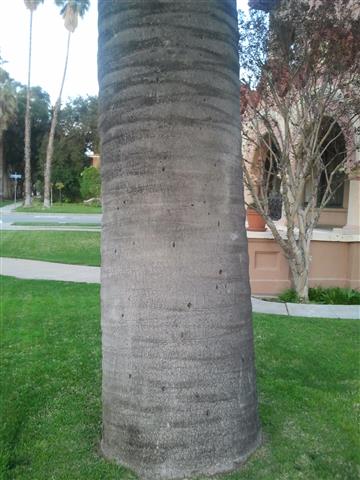
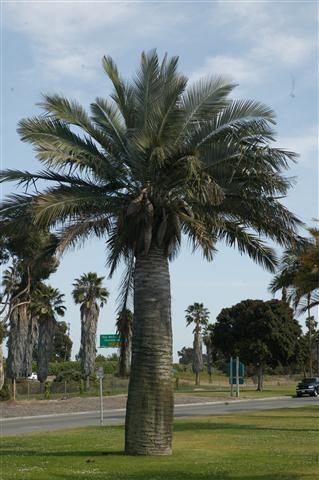
LIVISTONA CHINENSIS
THE CHINESE FAN PALM
SINGLE TRUNK, MEDIUM SIZE
This Asian species never really gets to a height much above 25 feet. It’s so slow growing that anything over ten feet seems to take an eternity. It has a twelve inch thick trunk and flat green leaves. In most areas it takes full sun but also tolerates filtered light. Cold hardiness is about 18 degrees F.
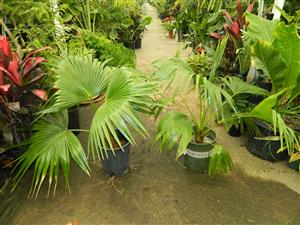
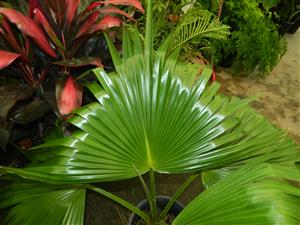
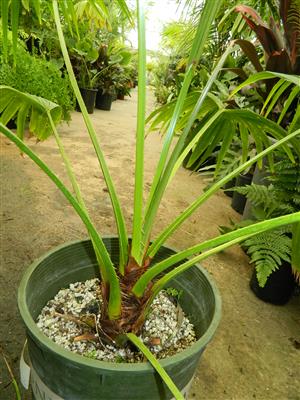
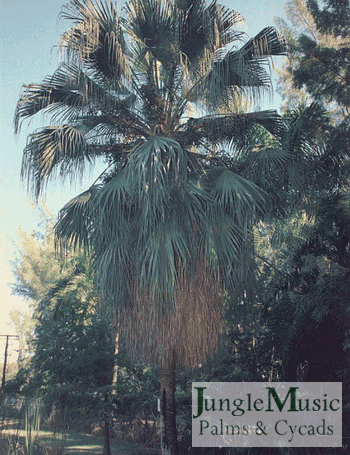
LIVISTONA DECIPIENS
AKA LIVISTONA DECORA
MEDIUM TO TALL HEIGHT, THIN TRUNK
This Australian fan palm can get over 40 feet tall, has a thin trunk and droopy leaflets. Because of the latter fact it’s known as the Ribbon Palm. Leaflets hang toward the ground. It likes full sun and is cold hardy into the upper teens F. It’s quite handsome.
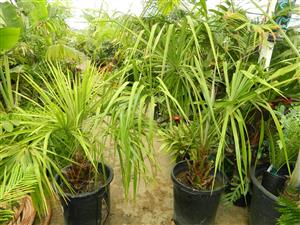
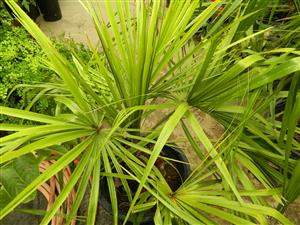
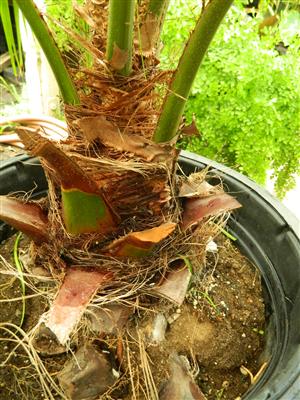
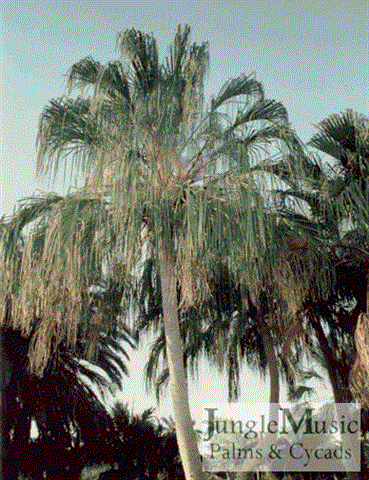
PHOENIX CANARIENSIS
THE CANARY ISLAND PALM
TALL WITH THICK TRUNK
This species of palm, native to the Canary Islands, has a thick trunk and gets to thirty, sometimes forty feet tall. It is slow growing as far as height is concerned. Leaves are green. It wants full sun, even in desert areas. You have to give it a lot of room to grow. Because of the way it’s trimmed below the leaves, some call it the “Pineapple Palm”. Cold hardiness is down to 18 degrees or a bit colder.
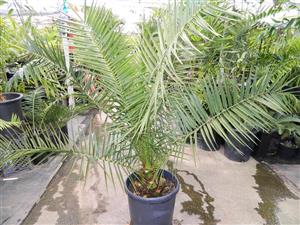
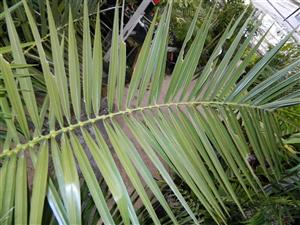
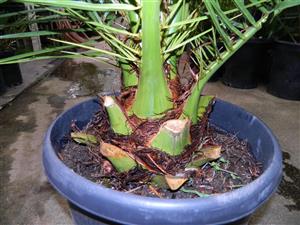
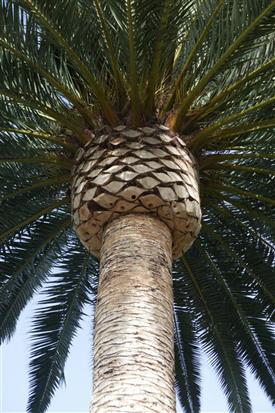

PHOENIX RECLINATA
THE SENEGAL DATE PALM
CLUMPING SPECIES MEDIUM SIZE
This is a type of Date Palm that clusters. It gets its name from the fact that trunks recline (lean) with age and height. It has a variable height. But, you can count on at least 15 feet. Some clumps get taller. It loves sun and is cold hardy into the upper teens F.
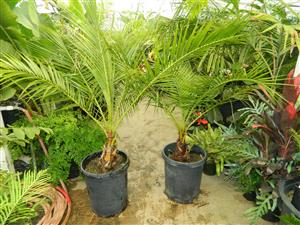
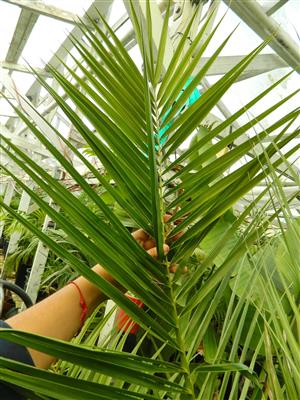
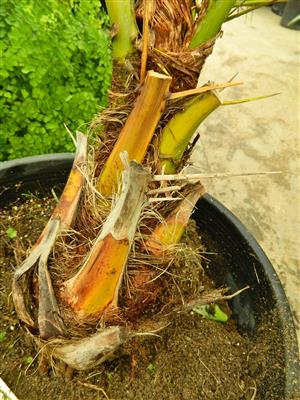
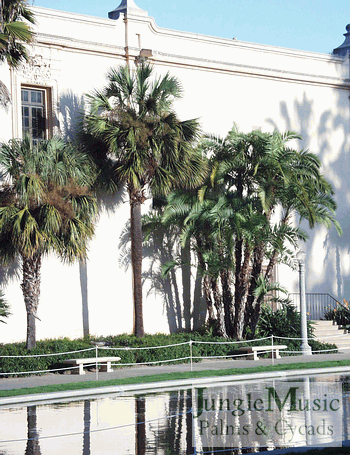
PHOENIX SYLVESTRIS
THE SILVER DATE PALM
MORE NARROW TRUNK THAN CANARY
For a Date Palm, this is a rather tall species and can get up to forty feet. The trunk is thinner than Phoenix canariensis and the leaves are more of a blue-green color than plain green. It wants full sun, can be grown in hot dry areas and has a cold tolerance estimated at about 20 degrees F. But, it’s not as cold hardy as the Canary Palm.


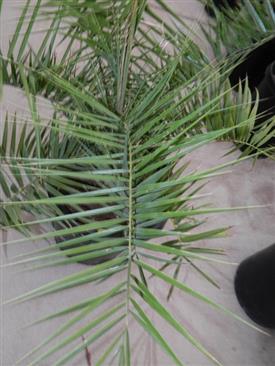

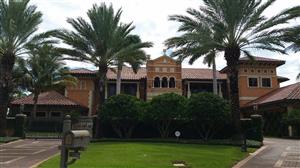
PHOENIX THEOPHRASTI
THE CRETAN DATE PALM
BUSHY AND NOT TOO TALL
This Date Palm is native to the island of Crete, southern Greece and some nearby islands. It is a suckering palm and not quite as tall as the Phoenix dactylifera. Its dates are not edible. Leaf color is typically lime green. Height can get up to thirty feet. Leaves are quite plumose. Cold tolerance is about 17 degrees or lower and it loves full and hot sun.
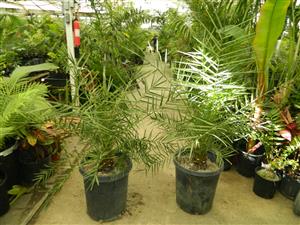

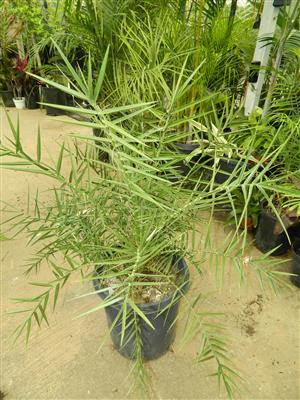
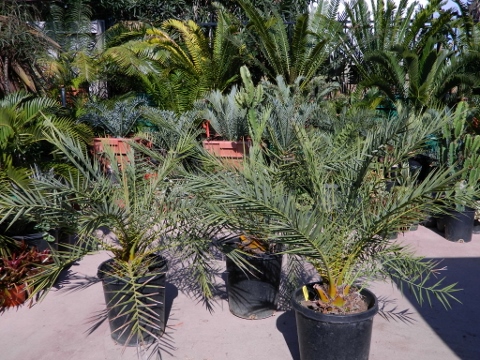
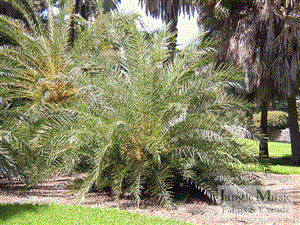
RHAPIS EXCELSA
THE LADY PALM
FOR FILTERED LIGHT
The Lady Palm can tolerate temperatures into the upper teens. It doesn’t do well with full sun but can take a little morning sun or filtered light. It has dark green fan leaves with prominent separation between the leaflets. Maximum height is variable – anywhere from six to twelve feet. It is slow growing and makes an excellent patio potted plant or interior palm. There are also rare variegated forms as shown in the fourth photo.
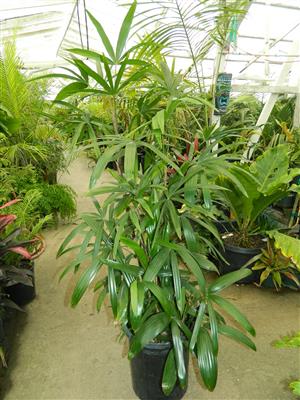
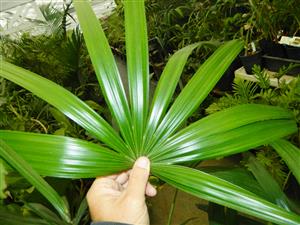
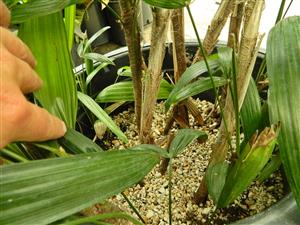
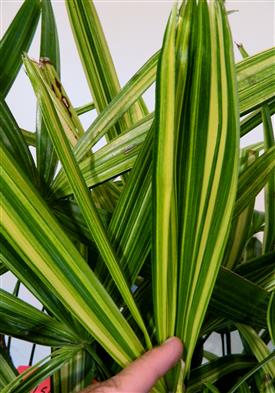

RHOPALOSTYLIS SAPIDA
THE SHAVING BRUSH PALM
THE FEATHER DUSTER PALM
V-SHAPED CROWN, BULGING CROWN SHAFT
I hesitated in showing this beautiful palm from New Zealand but have decided to list it here. This hesitation is because it’ll go down to the low 20’s F. but doesn’t like desert climates or hot, muggy summers. So, you must make sure it’s good for your area. There are folks growing it very well in Northern California and some parts of the San Joaquin Valley in California. It gets to about 25 feet tall, has an upright crown as shown and a small to medium sized trunk. The crown shaft bulges to a larger size than the trunk. It’s very popular.
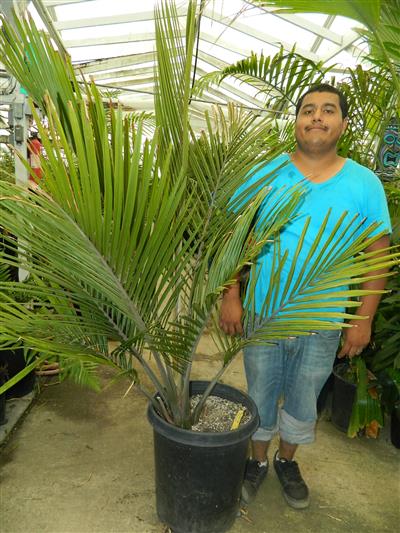
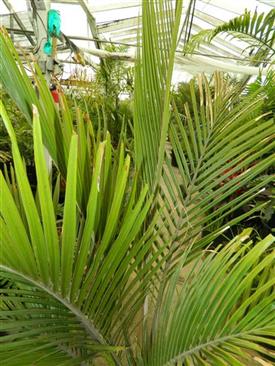
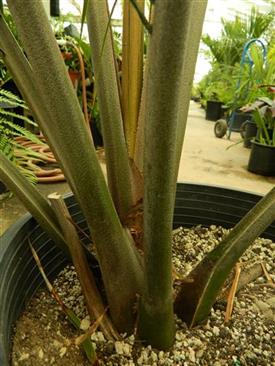
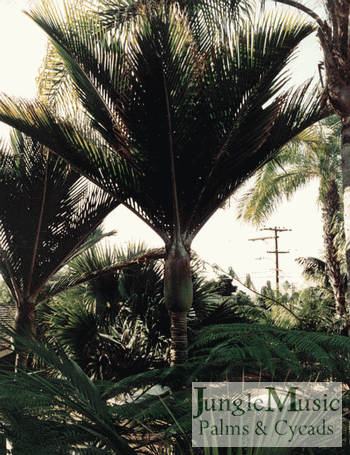

SABAL BERMUDANA
THE BERMUDA PALMETTO
THICK TRUNK, NOT TOO TALL
This fan palm is extremely cold hardy and is being grown in the Carolinas and Northern California. It has a thick trunk and gets to 20 to 25 feet tall. It wants full sun and is cold hardy down to about 16 degrees F. The leaves are large. It may be one of the most cold hardy of the Sabals.
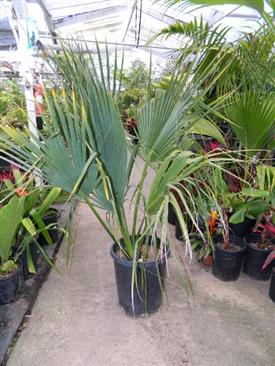
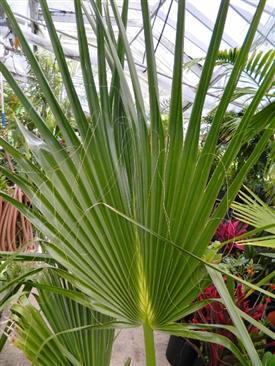
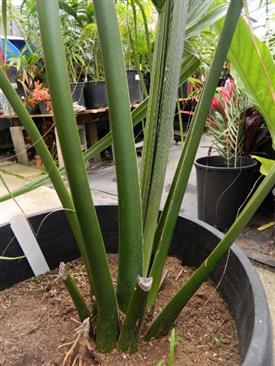
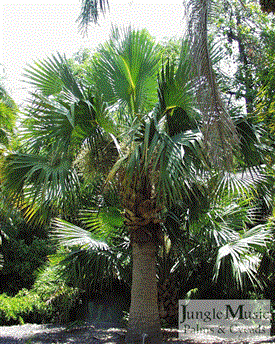
SABAL CAUSIARUM
TALL FAN PALM
THICK CONCRETE LIKE TRUNKS
This Caribbean fan palm can get rather tall, up to fifty feet. Its remarkable characteristic are the thick, concrete colored and appearing trunks. They are really impressive and get up to two feet thick. Leaf color is blue green. This palm loves sun and is cold hardy into the mid to upper teens F.
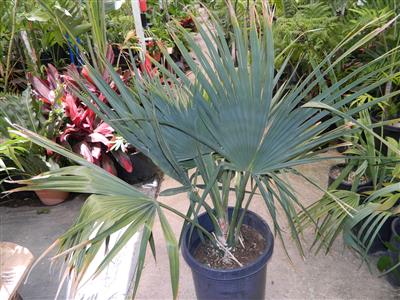
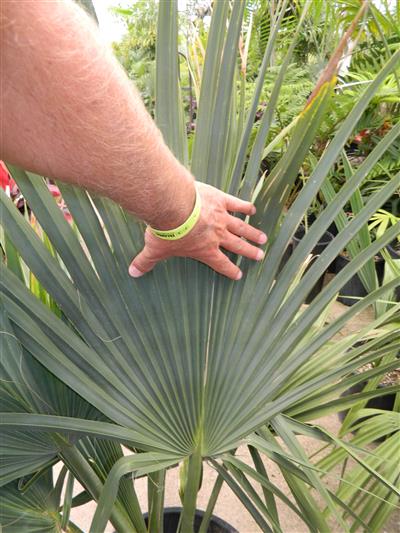
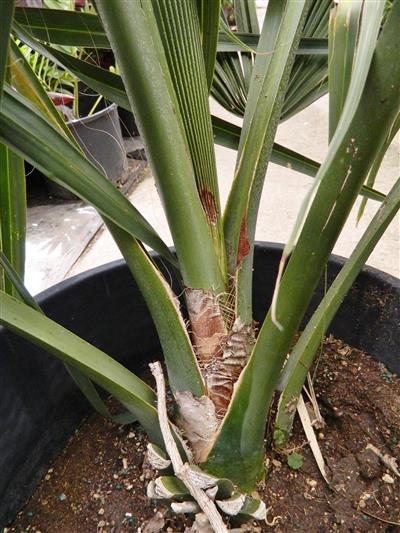
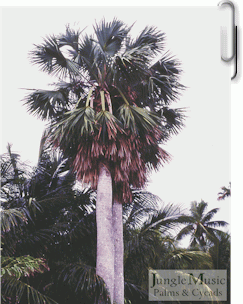
SABAL MINOR
THE SMALLEST SABAL
DWARF PALM – SIX FEET TALL
This fan palm is native to the southeastern part of the U.S. It rarely gets over six feet tall. It puts out blossoms that are taller than the leaves, producing many small black seeds. Leaves are sort of large compared to its dwarf height. It can take sun or shade and is cold hardy to 15 degrees.
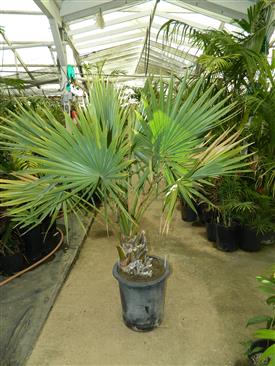
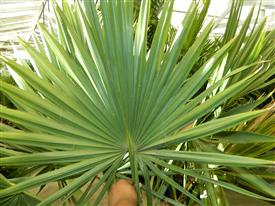
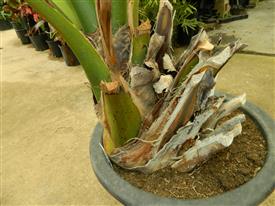
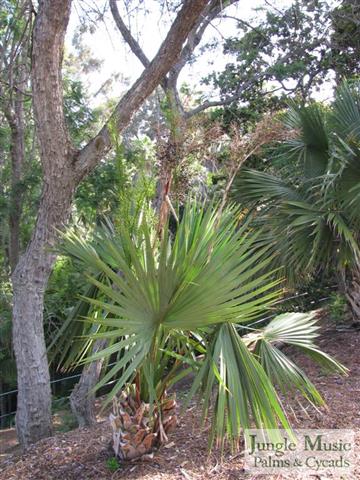
SERENOA REPENS
THE SAW PALMETTO
GREEN OR BLUE, SUCKERING
LOW PRFILE FAN PALM
This species is native to the south-eastern Gulf States and typically doesn’t get over six to eight feet tall. It loves hot sun and is cold hardy to the mid teens or perhaps a bit colder. We usually do not have 15g but rather just 5g size because it’s very slow growing.
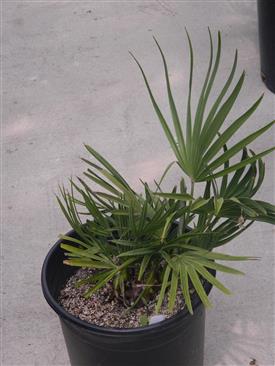
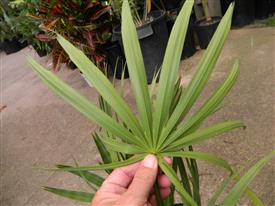

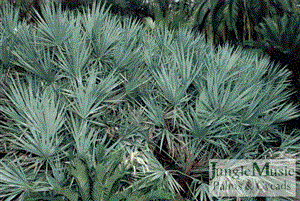
TRACHYCARPUS WAGNERIANUS
SMALL TO MEDIUM SIZE
SUPER COLD HARDY
SMALL, CUTE LEAVES
This Asian species of Windmill Palm is quite difficult to find. That’s because it’s very slow growing. The 15g plant shown here is about 8 years old. They typically don’t get tall. In a few decades, a ten foot palm could be expected. They love full sun and are cold hardy to 15 degrees F. Leaves are quite small and flat as shown here.
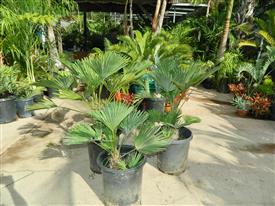
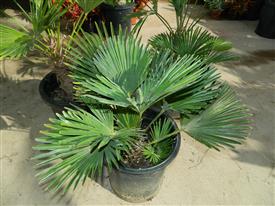
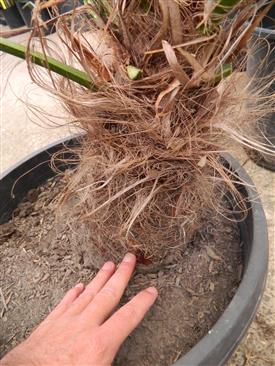
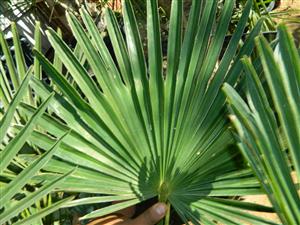
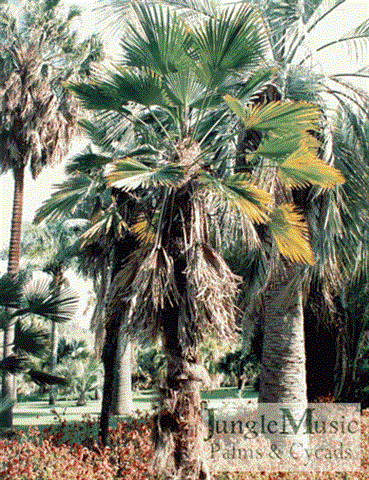
SYAGRUS SCHIZOPHYLLA X ROMANZOFFIANA
THE COCONUT QUEEN
BEAUTIFUL HYBRID PALM YET COLD HARDY
We don’t know as of yet the cold hardiness of this very handsome hybrid palm developed in Thailand. It’s quite a new thing. It is prettier than both parents. Anticipated height is 30 feet, so it’s shorter than a standard Queen Palm. It likes full sun and appears to be cold hardy down to about 20 degrees F.
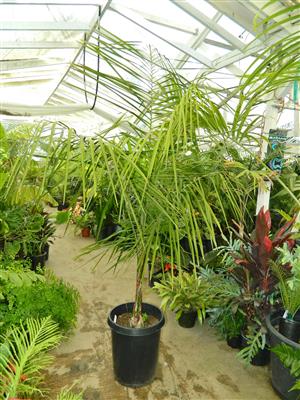
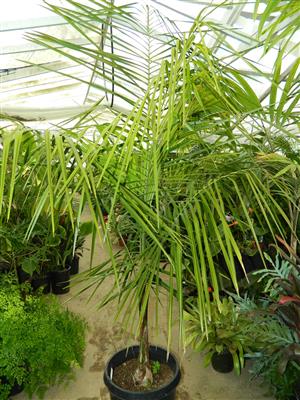
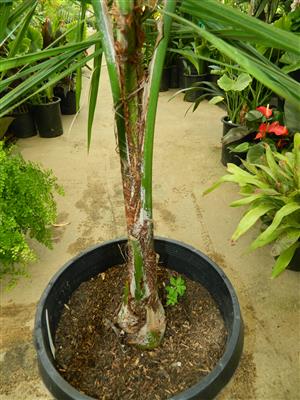
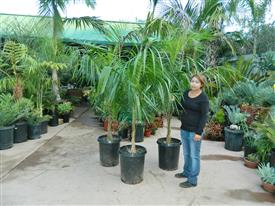
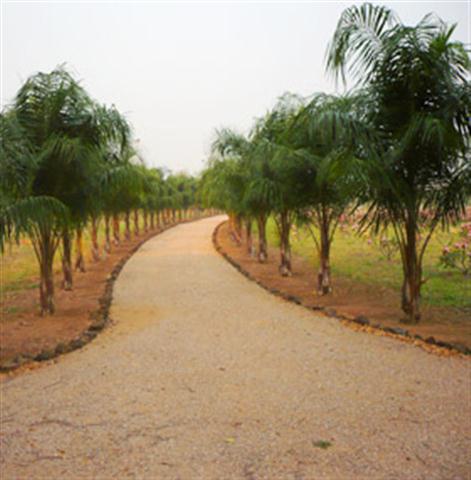
TRITHRINAX ACANTHICOMA
AKA TRITHRINAS BRASILIENSIS
MEDIUM HEIGHT, SPINEY TRUNK
This South American, single trunk fan palm is unlike some of its suckering kin below. This plant gets to a height of about 20 feet and has a random pattern of long spines protruding from the trunk. Leaves are green, medium sized. It likes sun and is cold hardy well into the upper teens F. The trunk is indeed different – liked by some, hated by others.
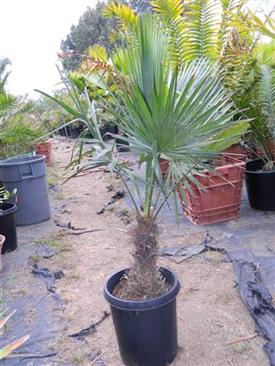
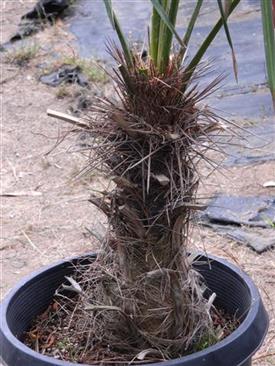
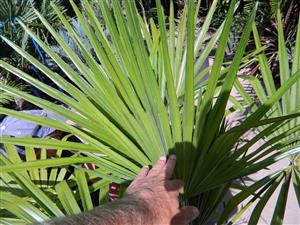
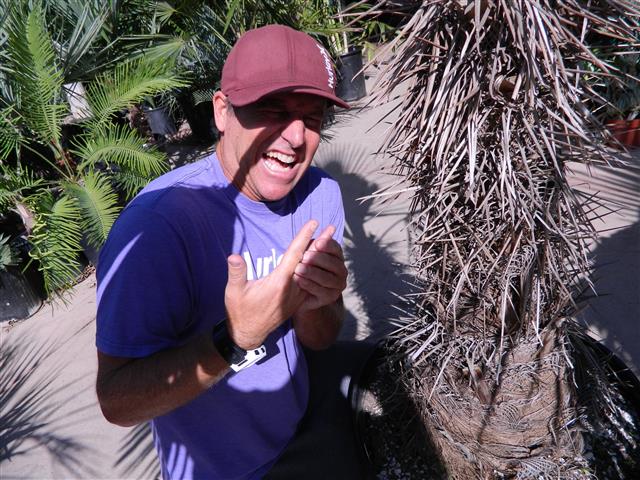
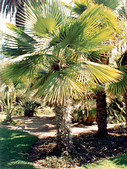
TRITHRINAX CAMPESTRIS
SUCKERING BLUE FAN PALM
MEDIUM HEIGHT
This South American species is nothing like T. acanthicoma above. It suckers, has a prominent blue color and has sharp points on the end of its leaf segments. But, it is attractive and cold hardy to about 17 degrees F. Expect a mature height of ten to twenty feet.
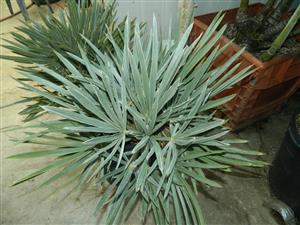

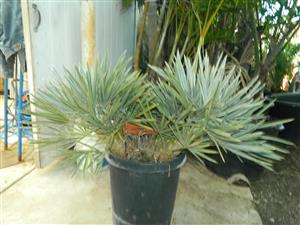

TRITHRINAX SCHIZOPHYLLAAKA TRITHRINAX BIFLABELLATA
SUCKERING, BLUE GREEN COLOR
This suckering South American fan palm is not as blue as T. campestris above and doesn’t have the wicked pointed leaves of that species. Color in blue green. It is very slow growing and extremely rare in cultivation. It likes full hot sun. Maximum height is 25 feet. Cold tolerance is about 20 degrees.
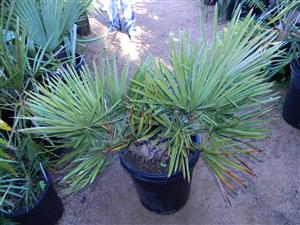
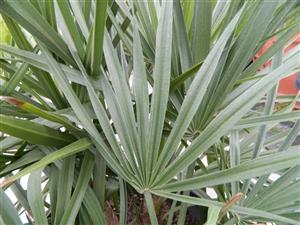
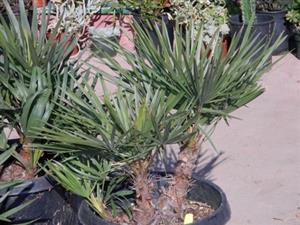
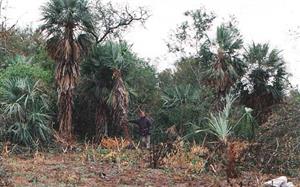
AFFORDABLE SHIPPING OF PLANTS BY THE PALLET – CALL FOR PRICING
Framed in pallet – Shrink wrapped – It’s on its way
HOW TO ORDER PLANTS: To get some of these 15g or larger cold hardy palms (or cycads, discussed elsewhere) all you need to do is to pick out the species you want. Typically this would be up to nine (or more) 15g plants. And, also pick some piggy-back 5g plants as well. It adds little in terms of shipping. Then call us (619 291 4605)and we design how to lay out the plants on the pallet and set up your pallet of plants. We get a trucking quote before you pay and let you know what that is. Billing information is taken over the phone. We typically can truck the plants out to you within 48 hours. If inclement weather exists in your area, we hold purchased plants for free until weather permits shipping.

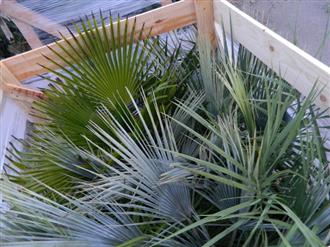
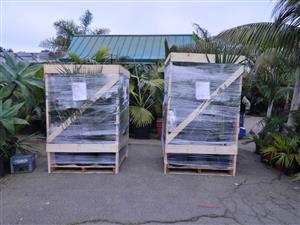
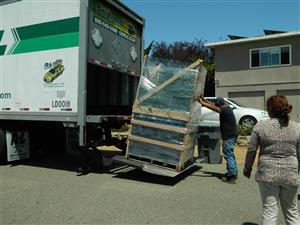
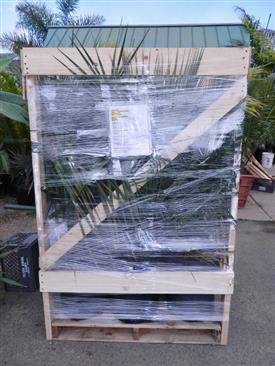
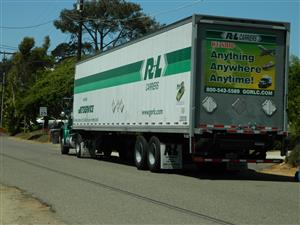
SUMMARY
For a very affordable fee, we can ship a good number of these palms to you. This can be twelve 15g plants and a lot of piggy back 5g plants, to many U.S. areas for as little as $500 to $700 trucking fee. The fee for the pallet is based on weight of all the plants and where it’s going – where you live. It does cost more to ship farther away, like the East Coast. The pallet size can be larger (we build our own), so one can actually have even more large plants on one pallet. Regarding the palms above, realize that species availability changes over time and we may run out of any of the palm above. But, if we don’t have them, we can usually find them for you. Or, if you want a smaller size, we may have it.
If you are serious about getting some cold hardy palm species, it’d be best to call us and talk to one of our staff. Besides cold, other factors such as summer heat and humidity are also important factors with successful growing. We’d make sure the species you want are right for your area. Finally, if you just want one or two palms, pallets aren’t your best bet. We’d ship those by common carriers. But, it’s easy to do and you get palms right to your front door.
Thanks for reading this.
Phil Bergman
Owner
- PALM TREES, CYCADS & TROPICAL PLANT BLOG - October 1, 2020
- TRACHYCARPUS
The Windmill Palm - September 30, 2020 - FAN PALMS –
PALMS WITH CIRCULAR LEAVES - September 29, 2020
